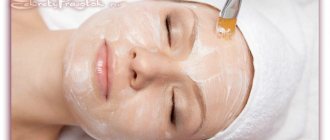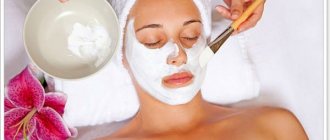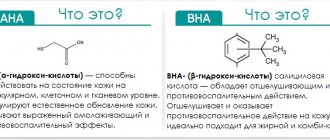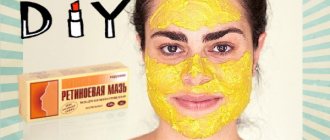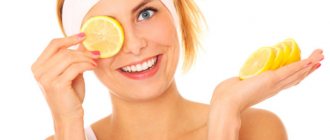You will undoubtedly be pleasantly surprised when you find out how beneficial milk peeling is for your facial skin. In cosmetology, it is one of the most effective drugs for combating skin imperfections.
And that's why:
- Lactic acid is an integral part of the skin's constituent components (natural moisturizing factor - NMF);
- Moisturizes, brightens, soothes the skin, reduces inflammatory manifestations, and also has an exfoliating effect;
- Refers to “summer” acids, that is, milk peeling can be used all year round;
Milk peeling is a targeted action on the skin with the aim of rejuvenating, moisturizing and superficially cleansing the skin, combating superficial wrinkles.
Indications and contraindications
However, milk peeling is a cosmetic procedure, and not a panacea for all facial imperfections. Therefore, it has both indications and contraindications.
Indications
Here are some facial problems you need to run to a cosmetologist for milk peeling:
- photoaging;
- dark spots;
- decreased tone and dyshidrosis of the skin;
- the appearance of superficial facial wrinkles;
- hyperkeratosis;
- acne - comedonal form of I degree;
- seborrhea.
Contraindications
Here's what milk peeling is incompatible with:
- individual intolerance to the components of the drug;
- presence of injuries on the face;
- inflammatory foci in the active phase;
- heart and vascular diseases;
- pregnancy;
- lactation period;
- malignant neoplasms;
- skin diseases (psoriasis, neurodermatitis, rosacea and others);
What happens during milk peeling
When using milk facial peeling, there is an increase in the intercellular matrix of hyaluronic acid and proteins, which are the structural elements of cells.
The procedure also helps to increase the thickness of the papillary layer of the dermis, which leads to an increase in the length of the dermal-epidermal junction. And this suggests the following: the exchange of oxygen, nutrients and waste between the avascular epidermis and the vascularized dermis will occur more actively.
One of the important properties of lactic acid is its ability to accelerate the process of cell renewal of the stratum corneum of the epidermis.
This is of great importance for various dermatological diseases, which are based on a violation of the keratinization process.
In addition to all of the above, lactic acid is able to regulate the pH of the skin towards an acidic environment. It will be an excellent addition in the treatment of dermatitis, acne, and fungal infections.
ATTENTION! Preparations based on lactic acid should not be used if the blood pH is below normal (oily skin - pH <4.0, normal skin - pH <5.2, dry skin - pH <5.7). Changes in pH values towards the acidic side can be observed with various skin diseases, for example, psoriasis.
The mechanism of action of lactic acid on the skin
- Gentle exfoliating effect : atraumatically eliminates excess keratinocyte layering, removes peeling and skin unevenness, and increases the penetrating ability of the remaining peeling ingredients.
- It is a component of NMF - a natural moisturizing factor of the skin, the deficiency of which is what causes dryness and flaking of the skin. Moisturizes and restores the skin.
- Stimulates the production of ceramides - restores the skin barrier - optimal for sensitive and sun-dehydrated skin.
- It has an anti-inflammatory effect due to its acidifying effect - it restores the pH of the skin.
- Whitens due to its exfoliating effect, and in higher concentrations due to the blockade of tyrosinase.
- Indirectly stimulates collagen synthesis , increases skin elasticity.
Advantages and disadvantages
Lactic acid is an excellent product that helps make your skin look flawless and get rid of many problems. But still, peeling based on lactic acid will not get rid of all possible changes in the skin of the face, although it will help prevent and slow down their occurrence.
Cosmetologists include the following advantages of lactic acid-based peeling:
- intensively moisturizes the skin;
- easily removes dead skin cells;
- smoothes superficial wrinkles;
- skin tone improves significantly;
- fights pigment spots;
- the relief of the skin is evened out;
- the rehabilitation period after peeling is minimal;
- can be carried out all year round;
- versatility of peeling for skin types;
- pronounced comedolytic and bacteriostatic effect.
But milk peeling also has disadvantages:
- although rare, an allergic rash to the components of the drug does occur;
- deep wrinkles cannot be corrected.
As you can see, the disadvantages are minor. We can say that there are none at all: allergies can happen to everything, and to combat serious age-related changes, there are medium and deep peels.
By the way, you can find out what type of aging your skin will change in order to choose the right care!
Regulation
Regulation (EU) No. 528/2012 Biocidal Regulation (BPR), in force since September 2013, provides detailed guidance on the use of biocidal products and their positioning on the market (1). It requires that only biocides approved by this regulation be placed on the EU market. The resolution applies to 22 types of products (PT), which can be classified into four main groups: disinfectants (PT1–5), preservatives (PT6–13), pest control products (PT14–20) and others (PT21–22) .
From September 1, 2015, in the production of final products, it is permitted to use ingredients with biocidal activity only from those manufacturers included in the approved list of suppliers as biocidal components (Article 95). Moreover, some of the traditionally used antibacterial components may disappear from the market due to non-compliance with regulatory requirements. For example, the well-known ingredient triclosan has not been approved by the Biocidal Products Regulatory Committee (BPRC) for use in group PT1 (personal care) products (2). This further fuels the search for safer natural alternatives and gives the green light for the use of organic acids such as L(+)lactic acid. In fact, the BPC has already formed a positive opinion and is ready to approve the use of lactic acid in PT1 products (3). Regulations on the use of lactic acid in products of groups PT2 (disinfection of non-food contact surfaces), PT3 (pet hygiene), PT4 (disinfection of food contact surfaces) and PT6 (canning production) are expected during 2022.
How to do milk peeling - step by step
Preparatory stage
On the eve of the procedure, you must avoid the solarium and hide your face from the sun's rays.
For three days, cosmetologists advise using lactic acid-based creams for gradual adaptation and, as a result, minimal side effects after the procedure.
Carrying out the procedure
- First, clean the skin. To carry out the procedure, a prerequisite is the presence of clean skin, which ensures uniform application of the drug to all areas of the skin.
- Toning. It is necessary to degrease and tone the skin.
- Pre-peeling. A special gel is applied to the face to prepare the skin for the application of lactic acid.
- Direct peeling. The drug is applied to the skin of the face, except for areas around the eyes and mouth, with a fan-shaped brush and cotton swabs. The drug should be applied in stages (forehead, temple, cheeks, then neck and décolleté, chin, around the mouth, nose, area around the eyes), in one or two layers with an interval of 10 minutes.
Exposure time depends on the expected depth of penetration of the drug (layers of the epidermis, dermis) - 2-20 minutes.
- Neutralization process. By applying a special composition, peeling is neutralized and water balance is restored.
Important! You can wash off any remaining products from your face only with cool water. Warm and, especially, hot water combined with lactic acid can cause skin irritation.
- Moisturizing and calming stage. To restore, calm, activate regeneration processes, as well as eliminate swelling, use appropriate masks and creams. Immediately after the procedure, be sure to apply a cream that contains SPF 30 or more.
Further skin care
You need to give your skin rest and the opportunity to recover. In the first few days, it is recommended to apply exclusively a moisturizer with an SPF of at least 30.
To achieve maximum results, it is recommended to take a course, which on average consists of 3 – 10 sessions with an interval of 8 – 14 days. This peeling can be repeated several times a year.
The recovery period lasts only a few days, but you must strictly follow the cosmetologist’s recommendations to achieve the maximum effect of the procedure.
Pharmacological properties
The drug has antiseptic, antiviral and antifermentation effects; it stops the proliferation of pathogens in the gastrointestinal tract, reduces intoxication, and relieves spasms.
Suppresses the proliferation of putrefactive bacteria in the gastrointestinal tract, destroys coccidia, reduces the formation of harmful substances during the decomposition of organic compounds in the body of cattle.
Acid improves digestion, accelerates metabolism, thereby accelerating the growth of animals and their productivity. When acting on a healthy stomach and intestines, it irritates it, which leads to improved digestion of roughage. Strengthens the gastrointestinal tract and immune system of cows.
The drug solution is used to disinfect areas of the skin where it has been damaged, as well as open wounds, keratinization sites and skin neoplasms. This helps speed up their healing.
Side effects
Like all cosmetic preparations, milk peeling has its side effects:
- Severe redness, which is most often observed in those with sensitive skin. This can be easily corrected with Panthenol cream;
- A burning sensation during peeling, which disappears during the neutralization stage;
- After the procedure, slight peeling of the skin is observed in the first 2 to 4 days;
- Minor redness of the skin, which goes away on its own within a few days;
- It is extremely rare that burns can occur as a result of an unprofessionally performed procedure.
Links
- Regulation (EU) No 528/2012 of the European Parliament and of the Council of 22 May 2012 concerning the making available on the market and use of biocidal products
- Opinion of the biocidal products committee on the application for approval of the active substance Triclosan in product type 1, ECHA/BPC/066/2015, adopted 17 June 2015
- Opinion of the biocidal products committee on the application for approval of the active substance L(+)-lactic acid in product type 1, ECHA/BPC/084/2015, adopted 10 December 2015
- Regulation (EC) No 1272/2008 on classification, labeling and packaging of substances and mixtures
- SP Denyer, GSAB Stewart, International Biodeterioration & Biodegradation 1998, 41, 261–268
- RE Glover, RR Smith, MV Jones, SK Jackson, CC Rowlands, FEMS Microbiology Letters 1999, 177, 57–62
- JD Van Hamme, A. Singh, OP Ward, Biotechnology Advances 2006, 24, 604–620
- JT Walton, DJ Hill, RG Protheroe, A. Nevill, H. Gibson, Journal of Applied Microbiology 2008, 105, 309–315
This article was originally published in Household and Personal Care Today, January/February 2022, Vol. 12(1), p. 20–21
How to perform milk peeling at home
Peeling based on lactic acid is one of the most delicate, so it can be done even at home. Before carrying out this procedure, carefully read and become familiar with the stages of peeling.
Carefully! Be sure to follow all instructions listed. Before applying peeling, you need to do a tolerance test . To do this, apply a small amount of the drug to the inner surface of the forearm and observe the reaction. If after a few minutes there are no negative reactions in the form of severe burning or itching, then you can safely begin the procedure.
To prepare the peeling you will need lactic acid , it can be purchased in the form of a solution with a concentration of 40% and 80%, and water .
How to calculate how much acid and water you need to take to get the desired concentration? Let's start with the fact that it is not recommended to use peeling at home with a concentration of more than 20%. A 4% or 10% solution is best.
How to obtain a solution with the desired concentration of lactic acid
Let's consider the example of a 40% lactic acid solution.
- To get 10g of 4% peeling, you need to take 1g of acid and 9g of water (4x10:40).
- To get 10g of 10% peeling, you need to take 2.5g of acid and 7.5g of water (10x10:40).
After preparing the product, you need to clean and tone the skin, then apply peeling for 2-5 minutes and use cool water to rinse the product off your face and moisturize with cream.
Regular use of milk peeling will make your skin moisturized, radiant, and help get rid of fine wrinkles, acne and age spots.
Towards environmental biocides
Hygiene and disinfection are an integral part of the daily life of a modern person. Biocides make the world safer and cleaner. However, the use of existing biocides, such as polychlorinated phenoxyphenols or isothiazolinones, is associated with possible risks to human health and the environment. Moreover, most of the existing components are synthetic chemicals, while the use of substances of biological origin is now increasingly encouraged. Green alternatives, such as naturally fermented lactic acid, have advantages over traditionally used biocides such as natural origin, effectiveness, safety and environmental friendliness.
In this work, we present the results of tests of the antibacterial effectiveness of liquid mixtures of lactic acid and surfactants. Their biocidal properties were studied using four common microorganisms using a standard protocol. L(+)lactic acid from Jungbunzlauer is obtained through fermentation from natural and renewable raw materials. It is ECOCERT certified as a raw material of natural origin for use in detergents and personal care products.
